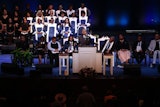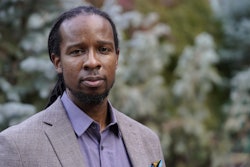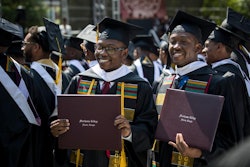Seeing a Dream Come to Fruition
Thirty years ago, the Rev. Father Boniface Hardin envisioned a language school for African-Americans, but what he founded has become so much more.
By Hurley Goodall
INDIANAPOLIS
Hidden away in a nondescript complex in one of the poorest neighborhoods in Indianapolis, Martin University is so modest that students and faculty park their cars in a tiny dirt-and-gravel lot across the street.
This institution of higher learning — the only predominantly Black university in Indiana — has served Indianapolis’ poor, minority and adult learners for 30 years.
Now, its founder and leader, the Rev. Father Boniface Hardin, is planning to step down. His final day as president will be Dec. 31, and he says he’s counting on students and faculty to select a leader who will continue his mission.
“As Dr. King said, the charisma is in the group. And I tell my students, faculty and staff, ‘You have to help the new president to know what the vision and the mission of Martin is,’” says the 73-year-old Hardin. “We don’t have a band. We don’t have a football team. All we have is learning.”
In addition to running the university, Hardin has received dozens of awards and honors for his work in the community.
The playwright and poet has produced and co-hosted television and radio programs and is versed in 15 languages. Hardin also uses his resemblance to the legendary abolitionist Frederick Douglass as a teaching tool.
His journey began in Louisville, Ky., where he was one of four children born into a deeply religious family. When he was a child, his Baptist mother converted to Catholicism. The rest of the family followed.
At 13, Hardin entered the Saint Meinrad Archabbey, a Catholic monastery in Indiana. There, he underwent a rigorous education in languages and theology, becoming a Benedictine monk in 1953. He was soon named assistant treasurer for the monastery, where he worked until enrolling at the University of Notre Dame’s School of Commerce in 1962.
“It didn’t satisfy me,” Hardin says of his work in the monastery. “So I asked to go to a parish. I didn’t know what God had planned for me, but that was part of God’s will that I learned about balance sheets and bookkeeping. God knew what I was going to do. God knew I was going to be here.”
As an ordained priest, Hardin was assigned to Holy Angels Church, a Black Catholic parish in Indianapolis. No longer living the secluded life of a monk, Hardin used his ministry to advocate for Black equality during the turbulent times of the civil
rights movement.
“I upset people because priests aren’t supposed to talk that stuff on Sunday morning,” he says. “Dr. King was a rabble-rouser. We didn’t want any of that.”
While at Holy Angels, Hardin established the Martin Center to provide psychological therapy for low-income Blacks in the community. But he wasn’t satisfied with the results. He says he felt that more could be done to further the goal of civil rights. He wanted to start a school, specifically one that would train Blacks in various languages.
“Of course, everyone thought I was crazy,” he says.
Steve Glenn, now a dean at Martin, was one of those initial skeptics. Glenn says he has known Hardin all his life, and when Hardin came to his family’s home in the 1970s with the idea, the college-aged Glenn didn’t take it seriously.
“I just kind of laughed,” he says. “You imagine a man walking up to you and saying he was going to start a school — I was incredulous.”
The language school never caught on. Hardin says he realized he couldn’t help anyone unless he could provide diplomas. Martin College, which later became Martin University, was fully realized in 1977 based on a liberal arts model. The school gained full accreditation in 1978. Since then, it has granted more than 1,200 degrees.
Hardin says the school’s mission is to educate low-income, minority adult learners in a healing and freedom-minded environment. According to the U.S. Census Bureau, only 4.3 percent of the population in the zip code that houses Martin hold four-year college degrees. Meanwhile, 24 percent of the population lives below the poverty line, a rate double that of the rest of the state.
“I didn’t try to reinvent the wheel,” Hardin says. “I don’t know if God gave me the smarts I need — he’s given me the wisdom to be able to have around me the people smart enough to help me with this particular thing. Then we can pull it together.”
Teaching at Martin is based on the principle of andragogy, a method of teaching that is specific to adult learning.
“We had made up our minds that we were going to deal with adults and teach them as adults,” says Sister Jane Schilling, the university’s founding vice president and its chief academic officer. She says the concept was founded by the late educational theorist Malcolm Knowles, who trained Martin’s faculty in his method.
In addition to the typical liberal arts curriculum, in which students must take courses in math, English, history and social sciences, students at Martin are also required to take a course in emancipatory narratives, where they learn the economic, psychological and social ramifications of oppression. The course is rooted in the ethno-therapy originally taught at the Martin Center. Students are also able to get college credit for their own life experiences, and are encouraged to bring those experiences into classroom discussions.
The university opened its doors with just two students. Today, the faculty of 40 educates a student body of 1,300, studying everything from business administration to music, chemistry and psychology.
Hardin says Martin is more than a school, it’s a movement.
“I came out of the civil rights movement,” he says. “And I said we can’t just do this thing piecemeal. We’ve got to take this all the way. Take our people, the poor — whatever color the poor is. They’re family.”
The search for Hardin’s successor continues, but the decision won’t be made solely by the school’s administration. According to both Hardin and Schilling, the decision will involve faculty, students and the community.
“During this time, I’m trying to lead my staff, faculty and students through what I call transformation, not transition, because it’s nervous times for a school to change leadership,” Hardin says.
Though he will be stepping aside in December, he is still taking strides to fund the school. Martin has entered the first phase of a $21 million capital campaign that will be used to expand the school’s facilities, which will include adding new computer labs. Glenn says Hardin has ambitions of making the university a residential campus.
“He’s still a dreamer, still a visionary,” Glenn says. “His heart and soul is in the school.”
–Hurley Goodall
There are currently 0 comments on this story.
Click here to post a comment.
© Copyright 2005 by DiverseEducation.com


















